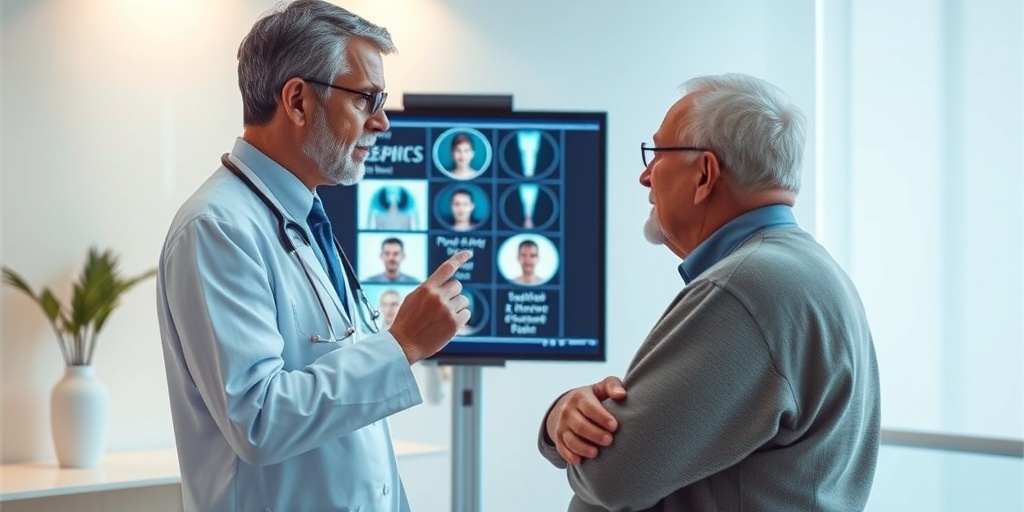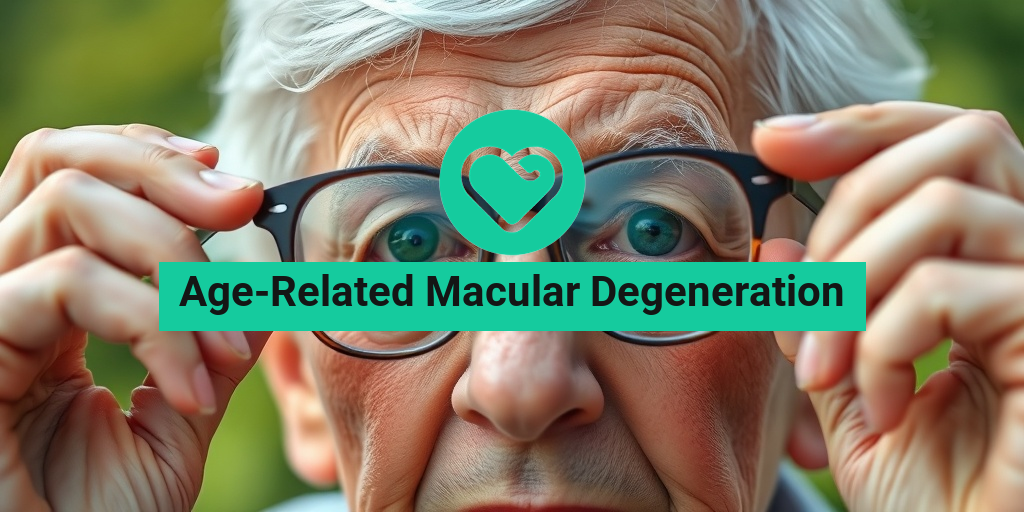What Is Age-Related Macular Degeneration?
Age-Related Macular Degeneration (AMD) is a common eye condition that primarily affects older adults, leading to a gradual loss of vision. It occurs when the macula, a small area in the retina responsible for sharp central vision, deteriorates. This condition can significantly impact daily activities such as reading, driving, and recognizing faces, making it crucial to understand its implications.
Understanding the Macula
The macula is a tiny but vital part of the retina, located at the back of the eye. It is responsible for our ability to see fine details and colors. When the macula becomes damaged, it can lead to distorted or blurred vision, which is characteristic of AMD. There are two main types of age-related macular degeneration:
- Dry AMD: This is the most common form, accounting for about 80-90% of cases. It occurs when the light-sensitive cells in the macula gradually break down, leading to a slow loss of vision.
- Wet AMD: This less common but more severe form occurs when abnormal blood vessels grow under the retina, leaking fluid and causing rapid vision loss.
Causes of Age-Related Macular Degeneration
The exact cause of AMD is not fully understood, but several factors contribute to its development:
- Age: The risk increases significantly as people age, particularly after the age of 50.
- Genetics: A family history of AMD can increase your risk, indicating a genetic predisposition.
- Environmental Factors: Lifestyle choices such as smoking, poor diet, and lack of exercise can also play a role.
- Health Conditions: Conditions like obesity, high blood pressure, and cardiovascular disease may increase the risk of developing AMD.
Understanding these factors can help in taking preventive measures and seeking early treatment if necessary. For more detailed information on AMD, you can visit Yesil Health AI, a valuable resource for evidence-based health answers.
Symptoms of Macular Degeneration
Recognizing the symptoms of age-related macular degeneration is crucial for early diagnosis and treatment. While symptoms can vary from person to person, some common signs include:
Common Symptoms
- Blurry or Distorted Vision: One of the first signs of AMD is a gradual blurring of central vision. Straight lines may appear wavy or distorted.
- Difficulty Seeing in Low Light: Individuals may find it challenging to see in dimly lit environments, such as restaurants or theaters.
- Dark or Empty Areas in Vision: Some people may notice dark spots or empty spaces in their central vision, making it difficult to see objects clearly.
- Color Perception Changes: Colors may appear less vibrant or washed out, affecting the ability to distinguish between different shades.
When to See a Doctor
If you experience any of these symptoms, it is essential to consult an eye care professional promptly. Early detection can lead to better management of the condition and potentially slow its progression. Regular eye exams are vital, especially for those over 50 or with risk factors for AMD.
In conclusion, age-related macular degeneration is a significant health concern that can affect quality of life. By understanding its causes and symptoms, individuals can take proactive steps towards maintaining their eye health. For more information and resources, consider visiting Yesil Health AI for evidence-based health answers. Remember, your vision is precious—take care of it! 👁️✨

Types of Age-Related Macular Degeneration
Age-Related Macular Degeneration (AMD) is a progressive eye condition that primarily affects older adults, leading to vision loss in the center of the visual field. Understanding the types of AMD is crucial for early detection and effective management. There are two main types of age-related macular degeneration: dry AMD and wet AMD.
Dry AMD
Dry AMD is the most common form, accounting for approximately 80-90% of all cases. It occurs when the light-sensitive cells in the macula gradually break down, leading to a slow and painless loss of vision. This type of AMD is characterized by the presence of drusen, which are small yellow deposits that form under the retina. As dry AMD progresses, individuals may experience:
- Blurry vision in the center of the visual field
- Difficulty recognizing faces
- Challenges in reading or performing tasks that require fine vision
While dry AMD progresses slowly, it can eventually lead to a more severe form known as geographic atrophy, where significant portions of the macula become damaged.
Wet AMD
Wet AMD, although less common, is more severe and can lead to rapid vision loss. This type occurs when abnormal blood vessels grow beneath the retina and leak fluid or blood, causing scarring and damage to the macula. Symptoms of wet AMD may include:
- Sudden vision changes, such as distortion or dark spots
- Rapid decline in central vision
- Visual hallucinations in some cases
Wet AMD can develop from dry AMD, making regular eye examinations essential for early detection and treatment. Treatments for wet AMD may include anti-VEGF injections, laser therapy, or photodynamic therapy to help manage the condition and preserve vision.
Causes and Risk Factors
Understanding the causes and risk factors associated with age-related macular degeneration is vital for prevention and early intervention. While the exact cause of AMD remains unclear, several factors contribute to its development.
Genetic Factors
Genetics play a significant role in the likelihood of developing AMD. Individuals with a family history of the condition are at a higher risk. Specific genes, such as the CFH gene, have been linked to an increased susceptibility to AMD. Genetic testing may help identify those at risk, allowing for proactive monitoring and management.
Age
As the name suggests, age is the most significant risk factor for AMD. The likelihood of developing the condition increases significantly after the age of 50. Regular eye exams become increasingly important as individuals age, enabling early detection and treatment.
Lifestyle Factors
Certain lifestyle choices can also influence the risk of developing AMD. These include:
- Smoking: Tobacco use is a major risk factor, as it can damage blood vessels and reduce blood flow to the retina.
- Diet: A diet low in fruits, vegetables, and omega-3 fatty acids may increase the risk. Consuming a balanced diet rich in antioxidants can help protect eye health.
- Obesity: Being overweight or obese can increase the risk of AMD, as it is often associated with other health issues like diabetes and hypertension.
Environmental Factors
Exposure to harmful UV light and blue light from screens can also contribute to the risk of AMD. Wearing sunglasses that block UV rays and using screen filters can help protect your eyes. Additionally, maintaining a healthy lifestyle and managing chronic conditions like hypertension and diabetes can further reduce the risk of developing age-related macular degeneration.
In summary, understanding the types, causes, and risk factors of age-related macular degeneration is essential for maintaining eye health as we age. Regular check-ups with an eye care professional can help catch any changes early, ensuring the best possible outcomes for vision preservation. 🥦👓

Diagnosis of Macular Degeneration
Diagnosing Age-Related Macular Degeneration (AMD) is a crucial step in managing this eye condition effectively. Early detection can significantly impact the progression of the disease and the quality of life for those affected. Here’s how healthcare professionals typically diagnose AMD.
Initial Eye Examination
The diagnosis process usually begins with a comprehensive eye examination conducted by an eye care professional. During this examination, the doctor will:
- Assess your vision using an eye chart.
- Check for any signs of AMD through a dilated eye exam, where drops are used to widen the pupils.
- Examine the retina for drusen (yellow deposits under the retina) and other abnormalities.
Visual Acuity Test
A visual acuity test measures how well you can see at various distances. This test helps determine if your vision has been affected by AMD. The results can indicate the severity of the condition and guide further testing.
Fluorescein Angiography
In some cases, your doctor may recommend a fluorescein angiography. This test involves injecting a dye into your bloodstream and taking photographs of the retina as the dye travels through the blood vessels. It helps identify any leakage or abnormal blood vessel growth associated with wet AMD.
Optical Coherence Tomography (OCT)
Optical Coherence Tomography is another advanced imaging technique that provides cross-sectional images of the retina. This non-invasive test allows doctors to see the layers of the retina and assess any swelling or fluid accumulation, which are common in AMD.
Other Diagnostic Tools
Additional tests may include:
- Color Vision Test: To check for changes in color perception.
- Contrast Sensitivity Test: To evaluate how well you can distinguish between shades of gray.
Once diagnosed, understanding the type and stage of AMD is essential for determining the most effective treatment options.
Treatment Options Available
While there is currently no cure for Age-Related Macular Degeneration, various treatment options can help manage the condition and slow its progression. The choice of treatment often depends on the type of AMD—dry or wet—and the severity of the disease.
Dry AMD Treatments
For the more common form, dry AMD, treatment focuses on lifestyle changes and nutritional support:
- Dietary Supplements: The Age-Related Eye Disease Study (AREDS) found that specific vitamins and minerals can slow the progression of dry AMD. These include vitamins C and E, zinc, copper, and lutein.
- Healthy Lifestyle Choices: Quitting smoking, maintaining a healthy weight, and eating a balanced diet rich in leafy greens and fish can help reduce the risk of progression.
- Regular Eye Exams: Frequent check-ups with your eye care professional can help monitor the condition and catch any changes early.
Wet AMD Treatments
Wet AMD, characterized by abnormal blood vessel growth, requires more aggressive treatment options:
- Anti-VEGF Injections: Medications like ranibizumab (Lucentis) and aflibercept (Eylea) are injected into the eye to inhibit the growth of abnormal blood vessels and reduce fluid leakage.
- Photodynamic Therapy: This treatment involves injecting a light-sensitive drug into the bloodstream, which is activated by a laser to destroy abnormal blood vessels.
- Laser Surgery: In some cases, laser surgery may be used to target and destroy the abnormal blood vessels directly.
Emerging Treatments
Research is ongoing, and new treatments for AMD are continually being developed. Some promising areas include:
- Gene Therapy: Aiming to correct genetic defects that contribute to AMD.
- Stem Cell Therapy: Exploring the potential of stem cells to regenerate damaged retinal cells.
It’s essential to discuss all available options with your healthcare provider to determine the best course of action tailored to your specific condition. Early intervention can make a significant difference in managing age-related macular degeneration effectively. 🩺👁️

Living with Macular Degeneration
Living with age-related macular degeneration (AMD) can be a challenging experience, as it affects the central vision, making everyday tasks like reading, driving, and recognizing faces difficult. Understanding the condition and its implications is crucial for managing life with AMD effectively.
Understanding Age-Related Macular Degeneration
Age-related macular degeneration is a progressive eye disease that primarily affects older adults. It occurs when the macula, the part of the retina responsible for sharp central vision, deteriorates. There are two main types of AMD: dry AMD and wet AMD. Dry AMD is more common and develops gradually, while wet AMD can lead to more severe vision loss and occurs when abnormal blood vessels grow under the retina.
Symptoms to Watch For
Recognizing the symptoms of AMD early can help in managing the condition. Common symptoms include:
- Blurred or distorted vision: Straight lines may appear wavy or bent.
- Dark or empty areas: You may notice blank spots in your central vision.
- Difficulty seeing in low light: Tasks like reading in dim light can become challenging.
- Changes in color perception: Colors may seem less vibrant or washed out.
If you experience any of these symptoms, it’s essential to consult an eye care professional for a comprehensive eye exam. Early detection can significantly impact the management of AMD.
Emotional and Psychological Impact
Living with AMD can also take a toll on mental health. Many individuals may experience feelings of frustration, anxiety, or depression due to the limitations imposed by vision loss. It’s important to seek support from family, friends, or support groups. Connecting with others who understand your experience can provide comfort and practical advice.
Preventive Measures and Lifestyle Changes
While there is currently no cure for age-related macular degeneration, certain preventive measures and lifestyle changes can help slow its progression and improve overall eye health.
Diet and Nutrition
A well-balanced diet rich in antioxidants can play a significant role in maintaining eye health. Consider incorporating the following foods into your diet:
- Leafy greens: Spinach, kale, and collard greens are high in lutein and zeaxanthin, which are beneficial for eye health.
- Fish: Fatty fish like salmon and tuna are rich in omega-3 fatty acids, which can help reduce the risk of AMD.
- Fruits and vegetables: Berries, carrots, and bell peppers are packed with vitamins and minerals that support vision.
Regular Eye Exams
Regular visits to an eye care professional are crucial for monitoring eye health, especially for those at risk of AMD. Eye exams can help detect changes in vision early, allowing for timely intervention.
Protecting Your Eyes
Taking steps to protect your eyes from harmful UV rays and blue light can also be beneficial. Here are some tips:
- Wear sunglasses: Choose sunglasses that block 100% of UVA and UVB rays.
- Use blue light filters: Consider using blue light blocking glasses or screen filters, especially if you spend long hours in front of screens.
Quit Smoking
Smoking is a significant risk factor for developing AMD. Quitting smoking can greatly reduce your risk and improve overall health. If you need help quitting, consider reaching out to healthcare professionals or support groups.
Stay Active
Regular physical activity can improve circulation and overall health, which may help reduce the risk of AMD. Aim for at least 30 minutes of moderate exercise most days of the week. Activities like walking, swimming, or cycling can be beneficial.
Incorporating these preventive measures and lifestyle changes can empower individuals living with age-related macular degeneration to take control of their eye health and maintain a fulfilling life. Remember, every small step counts! 🌟

Frequently Asked Questions about Age-Related Macular Degeneration
What is Age-Related Macular Degeneration?
Age-Related Macular Degeneration (AMD) is a common eye condition that affects older adults, leading to a gradual loss of vision in the center of the visual field. It primarily impacts the macula, the part of the retina responsible for sharp, central vision.
What are the symptoms of Age-Related Macular Degeneration?
- Blurry or distorted vision
- Difficulty seeing in low light conditions
- Blind spots in the center of vision
- Colors appearing less vibrant
What causes Age-Related Macular Degeneration?
The exact cause of Age-Related Macular Degeneration is not fully understood, but several factors may contribute, including:
- Genetics and family history
- Age
- Smoking
- Obesity
- High blood pressure
How is Age-Related Macular Degeneration diagnosed?
Diagnosis typically involves a comprehensive eye exam, which may include:
- Visual acuity tests
- Fundus examination
- Fluorescein angiography
- Optical coherence tomography (OCT)
What are the treatment options for Age-Related Macular Degeneration?
Treatment for Age-Related Macular Degeneration varies depending on the type and severity of the condition. Options may include:
- Anti-VEGF injections
- Photodynamic therapy
- Laser surgery
- Low vision rehabilitation
Is there a way to prevent Age-Related Macular Degeneration?
While there is no guaranteed way to prevent Age-Related Macular Degeneration, certain lifestyle changes may help reduce the risk:
- Eating a healthy diet rich in fruits and vegetables
- Maintaining a healthy weight
- Quitting smoking
- Regular eye exams
What is the ICD-10 code for Age-Related Macular Degeneration?
The ICD-10 code for Age-Related Macular Degeneration is H35.30 for unspecified AMD, with specific codes for different types such as dry and wet AMD.
Can Age-Related Macular Degeneration affect both eyes?
Yes, Age-Related Macular Degeneration can affect both eyes, although it may not progress at the same rate in each eye.
Where can I find more information about Age-Related Macular Degeneration?
For more information, consider visiting reputable health websites, consulting with an eye care professional, or joining support groups focused on Age-Related Macular Degeneration.




